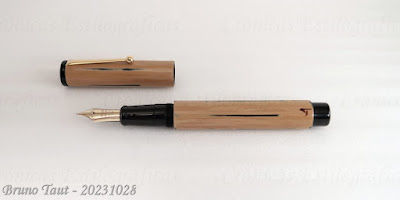First, the pen show in itself. 3 days, 180 tables, five shifts to attend it, most of them sold out. The figures clearly speak of a big success. It might not be what you expect from a pen show, but this East Asian style pen show does work, and, best of all, attracts younger generations of stationery aficionados.
And that because, as I have repeatedly said, TIPS is not a pen show but a stationery fair where many vendors simply display their latest products. More on this later.
The shift system –you pay to enter the show during a limited period of just four hours, morning or afternoon- is one of the unfortunate aftereffects of the pandemic years. What initially was a good idea to limit the number of people at the lounge at once and thus limiting the risk of infection is now an excuse to increase the total number of visitors and the revenue associated to selling tickets. The downside of it is easy to understand—this fair is not a meeting point for aficionados but just a market place where you better rush to see it all and to execute your purchases.
On this occasion, 2023, the large number of vendors –180- pushed the organizers to use two lounges on two different floors in the building. Moving between them could be very easy, but the organizers decided to make it difficult and unpleasant despite giving you a paper bracelet as soon as you entered the fair. It looked like they did not trust their own controlling mechanisms. But do not ask difficult questions...
So, what was on offer at TIPS 2023? More of the same things we saw on previous years: very few second hand and vintage pens, many more new pens, inks, paper, assorted paraphernalia...
However, I could see some new trends:
1. Timber, timber, timber! It seems wood lathes are on sale and the number of people making wooden pens –fountain pens, ball pens, mechanical pencils-- was surprising. But, is the market big enough for so many operations?
2. Emerging markets. TIPS was a success in previous years and some see this event as a good stage to present new companies and new products. In previous years we saw some European and American traders. This year, we also saw dealers from India, PR China and Turkey.
3. Urushi might be from East Asia, but now it is everywhere. And by urushi I also mean urushi-based decorative techniques. At TIPS 2023 we could see some interesting examples of urushi and raden decorated pens made in India and in Turkey.
Conclusions:
– The TIPS model –a stationery fair- works and is here to stay. Its ability to attract younger aficionados is a powerful argument to support this event in the years to come. Pens might not be the argument to attract them, but it does not matter as long as they come.
– New trends come and go. Wooden pens and urushi-decorated pens might be fashionable now, but everything can change overnight.
– Look out for products and companies coming from emerging markets as they will pose a very serious competition to well established companies.
Would I come again? Not sure. I always end up disappointed, but it is a good place to find out what is going on in the world of stationery.
Moonman A2 - Diamine Bilberry
Bruno Taut
November 8th, 2023
etiquetas: mercado, evento, Tokyo, maki-e
Bruno Taut
November 8th, 2023
etiquetas: mercado, evento, Tokyo, maki-e

























